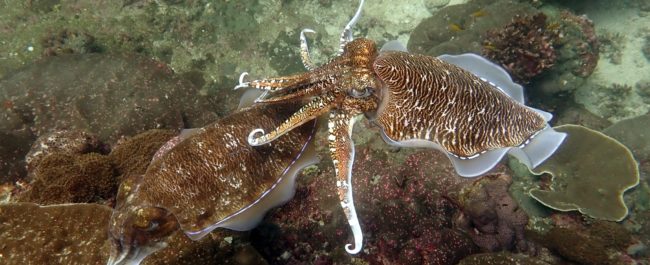Similan Islands diving tips
As a professional instructor working in Similan islands diving, I’m frequently asked by my divers what their chance will be of spotting manta rays. Any instructor worth their salt can tell you that in Similan islands diving your best bet is to dive Koh Bon if it’s manta rays you’re after. However, what most can’t give you are accurate odds – what is the percentage chance of manta rays on a dive at Koh Bon?
Fast-forward to 10 years’ worth of my Similan islands diving logbooks, a free afternoon, a pencil, and a rudimentary scoring system.
Drum-roll please… and the answer is, Koh Bon officially comes with a 32% chance of manta rays, with 85% of all my manta dives taking place between February and April.

Koh Tachai
And if your Similan islands diving is booked for November, should you skip Koh Bon? Absolutely not. The likelihood of mantas may be greatly reduced, but that’s not the only reason to dive this famous site.
Even discounting manta dives, some of my greatest dives of all time have taken place at Koh Bon. The soft corals at 30 meters will blow you away, I’ve had mating leopard sharks dancing round my head for half an hour, schools of barracuda encompassing my safety stop, and a good friend of mine even saw a whale shark whilst teaching a DSD!
But what if you are one of the chosen 32%? Then what? Well, here are my top three Similan islands diving manta tips:
-
-
Level off, and watch the clock!
-
You’re going to want to take a deep breath – I’d highly advise against it or you’ll be watching all the action from the surface in no time. Instead, keep a beady eye on your computer and adjust your breathing accordingly if you find yourself floating up or down. Also, watch your instructor, stay close and follow their lead. Oh, and check your air. Please don’t forget to check your air!
-
Stop swimming. Seriously. Stop it.
Unless your instructor is swimming, you shouldn’t be swimming. Yes, I know, it’s tempting as hell to follow the manta. But here’s the thing – you swim after a manta ray, it swims away for good. Stay still, stay calm, and it’ll circle you for hours. Unless of course it’s busy… mantas have shit to do too you know.
-
Put the camera down and feel the vibes.
Photographers – I know you won’t, but please get your head out of the camera. There are so many beautiful manta shots available, the chances of yours being the greatest are slim. And while a good shot may feel fantastic, you have absolutely no idea what you’re missing! The magic of dancing with these aquatic icons simply does not translate through a lens. Be in the moment, 100%, body and mind, and you’ll not regret it for a second.
Contact us
Error: Contact form not found.
